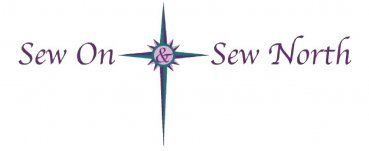Sew On & Sew North News 5/20/22

Hey everyone, I just wanted to share some information from Aurifil Threads on machine embroidery.
This information comes from Kate at Tough Kitten Crafts. She is one of the company's Aurifilosophers.
We carry 40 wt & 50 wt Aurifil threads. I can order in specialty packs of other sizes, just let me know.
KATE: In today’s Thread Matters post, I am going to do a breakdown of 4 thread weights by showing you how they look stitched out in various designs and telling you how you can duplicate my results at home. I have even provided the designs as a free download, so you can make your own thread weight samples, but more on that in a minute.
For each embroidery sample I have done 5 different designs:
- Box A (left) is a square that is digitized to be half as dense as typical embroidery fills. You will find this type of stitching in some “light stitching” designs and “thick thread” designs.
- Box B (right) is your typical embroidery density for a filled shape.
- Single Stitch is the innermost rectangle to show off how the thread stitches in a normal, single stitch (though it’s not super common in machine embroidery designs)
- Triple Stitch is next. This is common in machine embroidery– especially in quilting, redwork, and linework designs.
- Finally, the Blanket Stitch. You don't actually see this stitch often in machine embroidery but I love it and how it shows off the thread weights in both machine embroidery and regular sewing.
All four samples were stitched with 50wt Aurifil in the bobbin and a 90/14 Topstitch needle. The fabric is a canvas, stabilized with 1 layer of OESD fusible woven and one layer OESD Medium Weight Cutaway to ensure it looks great on camera. I hooped these designs in two separate hoopings using the standard hooping method.
12 Weight Thread
The 12wt samples look really good at first glance but I want you to notice some things about the boxes. Box A (to the left) is the box that has been digitized to be ½ as dense as typical embroidery and because of that, the 12wt thread has space to lay flat. Box B was digitized at the typical density for machine embroidery and while it stitched out fine with no issues during stitching, we can see that it caused some puckering and even distorted the fill pattern in the box. If you could feel it, you would notice box B is thick and even slightly raised from too many stitches in one area with such a thick thread. All in all, box A looks much better with the thickness of the 12wt thread.
Needle size: 90/14 or 100/16
Needle type: Topstitch
Bobbin Weight: 40wt or 50wt. Don’t use a “Bobbin weight thread” as it is too thin and will exacerbate potential tension issues.
Best types of designs for this weight thread: Open, airy designs. Sashiko, quilting, and redwork designs all work well. “Thick Thread” Designs.
Design types to avoid: Anything dense with a lot of satin and/or fill stitches.
Benefits of stitching with 12wt thread: 12wt thread is fantastic for creating beautiful texture and visual interest in your designs. It will help you mimic a hand stitched look with your embroidery machine.
Notes about stitching in this weight:
– Turn off your thread cutter
– May want to stitch slow
– I had no issue stitching out box B, which is a typical density of machine embroidery.
28 Weight Thread
I was so happy with how the 28wt sample turned out! This gorgeous thread weight really performed beautifully in every sample. Box A, with the lighter stitching, shows off the fill design really well while keeping a light look to the design. Box B, with the typical stitching, looks more dense than thread normally would in this design; it still looks great and has a nice thick density that likely wouldn’t cause any issues with a stitch out.
Needle size: 90/14. May be able to stitch with 80/12, though I stick with 90/14 to avoid issue.
Needle type: Topstitch
Bobbin Weight: 40wt or 50wt. Don’t use a “bobbin weight thread” as it is too thin and will exacerbate potential tension issues.
Best types of designs for this weight thread: “Light Stitching” designs show off the thread best, with open, airy fills. Can handle “regular” designs okay but will require a test stitch out to ensure density isn’t an issue.
Design types to avoid: Anything dense with a lot of stitching on top of other dense areas.
Benefits of stitching with 28wt thread: 28wt is less finicky than 12wt, but will still give more dimension to machine embroidered designs than embroidery weight threads.
Notes about stitching in this weight:
– Turn off your thread cutter




